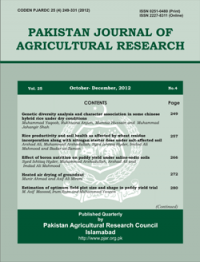IMPACT OF PHOSPHORUS LEVELS AND SEED RATES ON GROWTH AND YIELD OF LATE SOWN MAIZE ON HIGH ELEVATION IN SWAT, PAKISTAN
Imran*, Shaheeda Naveed**, Asad Ali Khan* and Inayat Khattak*
ABSTRACT
After nitrogen, phosphorus (P) is required by the plants relatively in large quantity and is the second most important crop nutrient that increases productivity of maize (Zea mays L.). An experiment on effect of different P O levels and seed rates on growth and yield of late sown maize cv. 2 5 Baber on high elevation during kharif season, was conducted at Farmer Field School, Swat, Pakistan during summer 2012. The experiment was laid out in randomized complete block design having three replications. Sowing was done one month late (July 15) than the optimum time of sowing. Optimum time of sowing on high elevation in Swat, Pakistan starts from May 15 to June 15. Four -1 -1 levels of P O (0, 25, 50 and 75 kg ha ) and four seed rates (10, 20, 30 and 40 kg ha ) 2 5 were used. A subplot size of 3m x 4.5m was used. Each subplot was consisted of six rows having 75 cm row-to-row distance with row length of 3 m. Sowing of 40 kg -1 -1 seed ha treated with 75kg P O ha gave optimum cob length (19 cm), plant height 2 5 -1 (179.19 cm), 1000 grain weight (192.83 g) and grain yield (2712 kg ha ). While maximum -1 -1 grain cob (375 ) was given by 30 kg seed ha treated with 75 kg P O . On 2 5 -1 the basis of the above results, among the tested seed rate 40 kg ha treated with 75 kg P O is recommended for late sowing on high elevation under the agro- 2 5 ecological conditions of Swat valley.
To share on other social networks, click on any share button. What are these?






